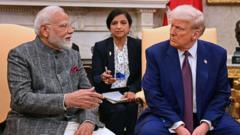With rising abdominal obesity, India's pot belly is now a key indicator of imminent health crises.
**The Silent Epidemic: India's Pot Belly Crisis**

**The Silent Epidemic: India's Pot Belly Crisis**
India's transformation from a status symbol to a health hazard underscores an obesity epidemic.
In recent decades, the Indian pot belly has shifted from being a symbol of prosperity to a pressing health concern, emblematic of the country's growing obesity crisis. Once a celebrated hallmark of comfort, the expansion of waistlines has increasingly become associated with serious health risks, with a new analysis indicating a rapid rise in obesity rates in India. A report from The Lancet suggests that the number of overweight or obese adults in India could surge from 180 million in 2021 to 450 million by 2050, signifying a potential third of the future population.
Obesity, as highlighted in the latest National Family Health Survey (NFHS-5), is not merely a cosmetic issue. A significant 40% of Indian women and 12% of men exhibit signs of abdominal obesity, which can lead to health complications such as Type 2 diabetes and cardiovascular diseases. Furthermore, urban populations are disproportionately affected, with waist measurements indicating alarming trends.
The alarming reality is that the distribution of fat in the body plays a crucial role in health outcomes. Abdominal obesity disrupts insulin usage, which is critical for blood sugar control. Studies have shown that South Asians, including Indians, may carry more body fat compared to others at similar BMIs, contributing to higher risks of metabolic issues.
The emerging understanding of obesity in South Asian populations prompted Indian health experts to redefine obesity guidelines, focusing on fat distribution's implications for health. This classification prompted a two-tier clinical approach, distinguishing between those who may require lifestyle changes versus those facing dire health threats.
Doctors attribute this epidemic to dietary shifts towards more processed foods and sedentary lifestyles, which have intensified within India. Experts recommend substantial lifestyle changes tailored to South Asians' specific metabolic profiles—more exercise than typically required in Western norms to mitigate obesity's effects.
As the once-mirthful pot belly morphs into a silent health threat, the imperative for effective action has become crucial. Recognizing the prevalence of dangerous abdominal fat, even among those classified as healthy, underscores the need for vigilant health strategies as India grapples with this growing crisis.
Obesity, as highlighted in the latest National Family Health Survey (NFHS-5), is not merely a cosmetic issue. A significant 40% of Indian women and 12% of men exhibit signs of abdominal obesity, which can lead to health complications such as Type 2 diabetes and cardiovascular diseases. Furthermore, urban populations are disproportionately affected, with waist measurements indicating alarming trends.
The alarming reality is that the distribution of fat in the body plays a crucial role in health outcomes. Abdominal obesity disrupts insulin usage, which is critical for blood sugar control. Studies have shown that South Asians, including Indians, may carry more body fat compared to others at similar BMIs, contributing to higher risks of metabolic issues.
The emerging understanding of obesity in South Asian populations prompted Indian health experts to redefine obesity guidelines, focusing on fat distribution's implications for health. This classification prompted a two-tier clinical approach, distinguishing between those who may require lifestyle changes versus those facing dire health threats.
Doctors attribute this epidemic to dietary shifts towards more processed foods and sedentary lifestyles, which have intensified within India. Experts recommend substantial lifestyle changes tailored to South Asians' specific metabolic profiles—more exercise than typically required in Western norms to mitigate obesity's effects.
As the once-mirthful pot belly morphs into a silent health threat, the imperative for effective action has become crucial. Recognizing the prevalence of dangerous abdominal fat, even among those classified as healthy, underscores the need for vigilant health strategies as India grapples with this growing crisis.

















